You’ll need a three-stage approach for professional gold polishing: start with aggressive cutting compounds like Brown Tripoli to remove deep scratches, progress to White Diamond or White Rouge for intermediate smoothing, and finish with Red Jewelers Rouge for that mirror-like shine. Each compound requires dedicated buffing wheels to prevent cross-contamination. Zam compound offers excellent cutting power while being gentle on delicate surfaces. Proper equipment selection and contamination control will reveal the secrets to achieving flawless, jewelry-grade finishes.
Understanding Different Types of Gold Polishing Compounds
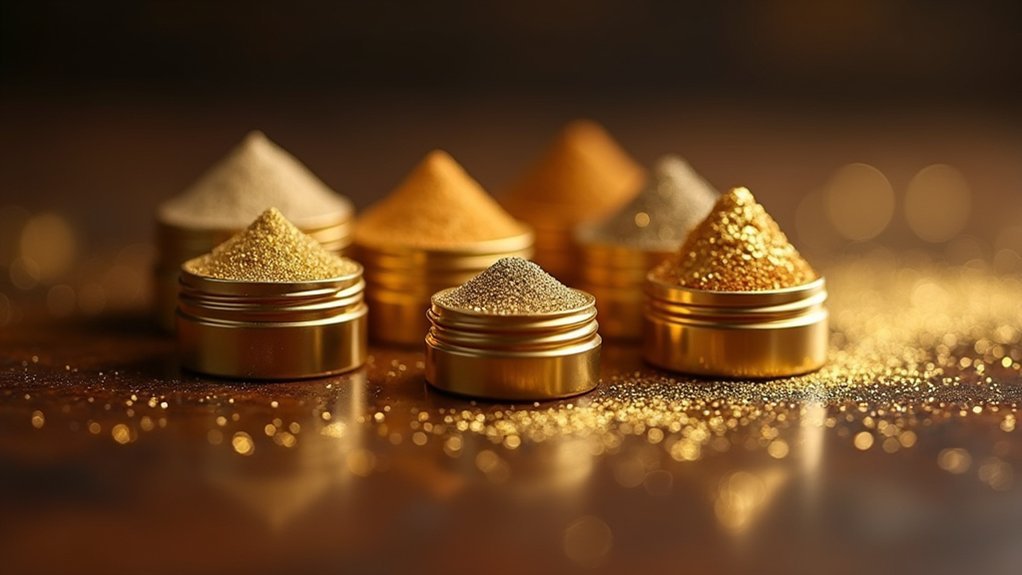
When you’re working with gold jewelry or precious metal pieces, you’ll need to understand that polishing compounds fall into three distinct categories based on their cutting action and intended purpose.
First cut compounds tackle rough surfaces and heavy scratches, providing aggressive material removal.
Second cut compounds work on semi-smooth surfaces, offering moderate cutting action for intermediate polishing stages.
Final polishing compounds deliver the high luster finish you want without removing material.
Each type of jewelers polishing compound serves a specific function in your workflow.
Each polishing compound type has a distinct role in achieving professional jewelry finishing results.
You’ll achieve better results when you match the right compound with an appropriate polishing wheel.
Gold polishing compounds require careful selection since gold’s softness demands compounds that won’t over-cut or damage the precious metal’s surface integrity.
Red Jewelers Rouge for Gold Finishing
Red Jewelers Rouge stands as the gold standard for achieving mirror-like finishes on precious metal jewelry. This specialized polishing compound delivers exceptional results on soft non-ferrous metals, making it your go-to choice for gold finishing work.
The semi-wet bar formula minimizes cutting while maximizing shine, ensuring you’ll achieve that coveted high luster without damaging delicate surfaces.
For ideal performance, pair Red Jewelers Rouge with these buffing wheels:
- Untreated domet flannel wheels for gentle polishing
- Spiral sewn wheels for controlled application
- Loose muslin wheels for final finishing touches
You’ll find this compound particularly effective during final polishing stages, where achieving maximum brilliance matters most.
Professional jewelers rely on Red Jewelers Rouge because it consistently produces mirror-like finishes without introducing scratches or imperfections to precious gold pieces.
Tripoli Compound Applications on Gold Jewelry
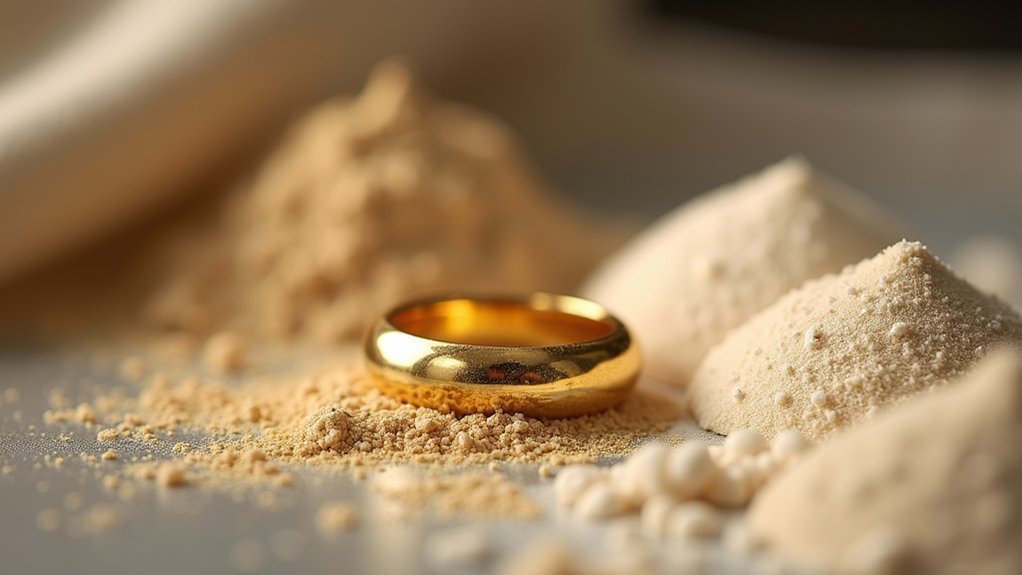
Before achieving that final mirror finish, you’ll need Tripoli compound to tackle the preliminary work of removing scratches and surface imperfections from your gold jewelry. This versatile compound works effectively on yellow, white, and rose gold pieces through its aggressive cutting action.
You should apply it using yellow treated buffing wheels for peak performance without damaging the metal surface. Maintain a clean workspace and switch buffing wheels between different compounds to prevent cross-contamination.
Use Tripoli as your first step in a multi-stage polishing process, followed by finer compounds like Zam for that high-luster finish. This systematic approach guarantees you’ll achieve professional-quality results on all your gold jewelry pieces while preserving their integrity throughout the entire polishing process.
White Diamond Polishing for High-Luster Gold
After completing your initial polishing with Tripoli compound, White Diamond polishing compound becomes your go-to choice for achieving that coveted high-luster finish on gold jewelry.
This specialized compound excels at removing fine scratches while delivering exceptional shine on rigid metals like gold.
White Diamond stands out among polishing compounds for its second cut capabilities, making it perfect for the final stages of jewelry buffing.
You’ll achieve peak results by following these essential steps:
- Pair White Diamond with a tight weave muslin buffing wheel for maximum effectiveness
- Apply minimal pressure during buffing to allow the compound to work properly
- Use it as your final polishing step after coarser compounds for mirror-like results
This approach guarantees your gold pieces achieve that brilliant, professional-quality finish jewelers demand.
Bobbing Compound Techniques for Initial Gold Preparation
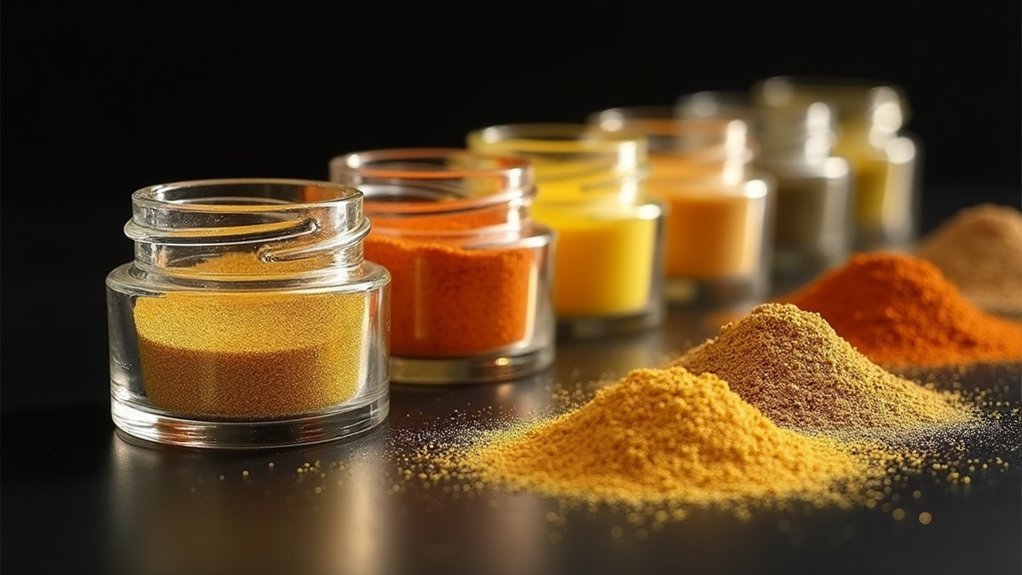
Precision marks the difference between amateur and professional gold finishing, and that distinction begins with proper bobbing compound techniques during initial preparation.
You’ll want to start with Black Emery or Brown Tripoli bobbing compounds, which effectively remove deep scratches and surface imperfections. Apply these compounds using a yellow treated buffing wheel for ideal results.
Your technique matters greatly—always buff from the wheel’s equator downward to maintain safety and maximize effectiveness. This downward motion prevents the gold piece from catching and guarantees consistent coverage across the surface.
Always buff from the wheel’s equator downward to maintain safety and maximize effectiveness while preventing workpiece catching.
After completing the bobbing stage, thoroughly clean your gold piece to prevent cross-contamination with finer polishing compounds.
This initial preparation creates the foundation for achieving that coveted high-luster finish in subsequent stages.
Zam Polishing Compound Benefits for Gold Surfaces
You’ll find Zam polishing compound offers exceptional cutting power while delivering the high-luster finish that gold jewelry demands.
This versatile compound excels at removing tarnish and oxidation from various gold alloys without scratching delicate surfaces.
When you’re ready to achieve that coveted mirror-like finish, Zam works best with muslin or flannel buffing wheels for ideal results.
Zam Compound Properties
Among the various polishing compounds available, Zam stands out for its exceptional ability to deliver a brilliant, high-luster finish on gold surfaces without causing damage.
This Zam polishing compound is specifically engineered for precious metals, offering unique properties that make it indispensable for professional jewelers.
Key properties that set Zam apart include:
- Non-abrasive formula – Won’t scratch or damage delicate gold surfaces while enhancing reflective quality
- Universal compatibility – Works effectively on various gold alloys and soft metals
- Enhanced application efficiency – Pairs perfectly with flannel buffing wheels for even distribution
You’ll find that Zam’s formulation excels in buffing and polishing applications, removing tarnish and minor imperfections while maintaining gold’s integrity.
Regular use guarantees your jewelry pieces retain their aesthetic appeal and brilliant shine.
Gold Surface Applications
When working with gold surfaces, Zam polishing compound delivers exceptional results that transform ordinary pieces into mirror-like masterpieces. This white polishing compound excels at enhancing gold’s natural luster without removing significant material, making it perfect for valuable jewelry pieces.
You’ll achieve professional-grade finishes that rival those found in high-end establishments. The jewelry polishing compound works seamlessly with tight weave muslin wheels, ensuring even distribution while minimizing surface damage.
You can effectively remove any scratches and minor imperfections that diminish your gold’s appearance. Zam’s fine formulation creates smooth, flawless surfaces that showcase gold’s inherent beauty.
Regular application prevents tarnish buildup and maintains long-lasting shine. Whether you’re restoring vintage pieces or finishing new creations, Zam consistently delivers the mirror-like results that distinguish professional work from amateur attempts.
Choosing the Right Buffing Wheels for Gold Compounds
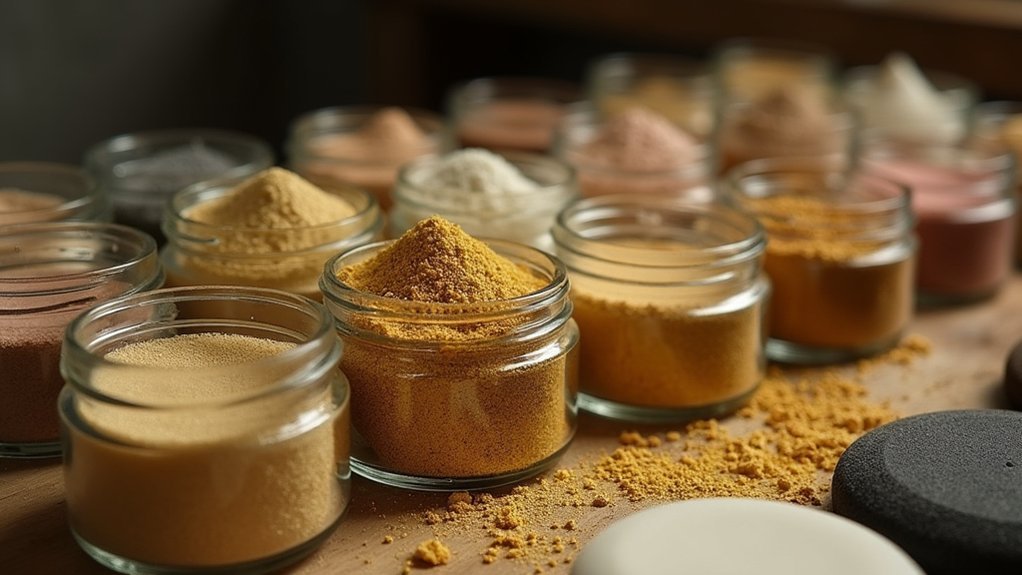
Since gold’s soft nature makes it susceptible to scratching, selecting the proper buffing wheels becomes essential for achieving professional results.
You’ll need different wheels for various stages of your polishing process.
For best results with polishing compounds, follow this wheel selection guide:
- Cutting Stage: Use sisal buffing wheels with Brown Tripoli to remove deep scratches and imperfections from gold surfaces.
- Final Polishing: Switch to untreated domet flannel or loose muslin wheels paired with Red Jewelers Rouge for achieving maximum shine without damaging the metal.
- Wheel Maintenance: Keep separate buffing wheels exclusively for gold work to prevent cross-contamination from other metals.
Remember to clean your wheels regularly and never mix compounds between different wheel types to maintain consistent, professional-quality finishes.
Progressive Polishing Steps From Coarse to Fine
You’ll achieve the best results by following a systematic progression from coarse to fine compounds when polishing gold.
Start with an initial cutting compound to remove deep imperfections, then move to a medium cut preparation stage for smoothing.
Complete the process with a final high polish compound that delivers maximum shine and luster.
Initial Cutting Compound Selection
Four distinct compounds form the foundation of professional gold polishing, each serving a specific purpose in the progressive refinement process. Your initial cutting compound selection determines the efficiency of removing deep scratches and surface imperfections from gold pieces.
Black Emery serves as your primary emery compound for aggressive cutting action. This coarse polishing (buffing) compound effectively eliminates substantial surface damage and prepares your workpiece for subsequent refinement stages.
Consider these essential factors when selecting your initial cutting compound:
- Surface condition assessment – Evaluate scratch depth and oxidation levels to determine appropriate abrasive strength.
- Gold alloy composition – Softer alloys require gentler initial compounds to prevent excessive material removal.
- Wheel compatibility – Match compound consistency with buffing wheel specifications for ideal compound adhesion and cutting performance.
Medium Cut Preparation
The medium cut preparation phase bridges the gap between aggressive initial cutting and fine finishing work, requiring careful compound selection and technique refinement.
After completing your initial cut with Brown Tripoli, you’ll shift to finer polishing compounds like White Rouge to enhance your gold’s brightness without excessive material removal.
This critical step demands a dedicated buffing wheel to prevent cross-contamination that compromises finish quality.
White Rouge excels at removing the microscopic scratches left by coarser compounds while building the foundation for your final high-luster finish.
Verify you’ve properly prepped your gold surface to 600 grit before beginning medium cut preparation.
This progressive approach systematically refines the surface, setting up ideal conditions for your finishing compound application and achieving professional-grade results.
Final High Polish
Precision defines the final high polish stage, where Red Jewelers Rouge transforms your gold’s surface into a mirror-like finish that rivals professional jewelry standards.
After completing medium cut preparation with White Rouge, you’ll shift to this ultimate polishing compound that creates brilliant luster without cutting into your precious metal.
The progressive approach guarantees flawless results when finishing your jewelry:
- Apply Red Jewelers Rouge to a dedicated buffing wheel, maintaining consistent pressure throughout
- Work systematically across the gold surface using overlapping motions to prevent streaking
- Clean frequently between applications to remove debris and maintain compound effectiveness
You must use separate wheels for each polishing stage to prevent cross-contamination.
These compounds work together in sequence, building from coarse correction to fine perfection, delivering that coveted mirror finish every jeweler seeks.
Professional Gold Polishing Equipment and Tools
When you’re serious about achieving professional-grade results on gold jewelry and accessories, investing in specialized polishing equipment becomes essential.
You’ll need quality buffing wheels like untreated flannel and spiral sewn muslin to work effectively with your compounds. These wheels won’t damage delicate gold surfaces while delivering superior results.
Your rotary tool or buffer generates the friction necessary to properly dress the buff and maximize polishing effectiveness.
The friction from your rotary tool properly conditions the buffing wheel for maximum polishing performance on precious metals.
For ideal metal polish applications, start with coarser compounds like Brown Tripoli for cutting, then progress to finer options like Red Rouge for mirror finishes.
Remember to clean your equipment between compound applications. This prevents cross-contamination and maintains consistent quality across all your gold polishing projects.
Maintaining Contamination-Free Gold Polishing Results
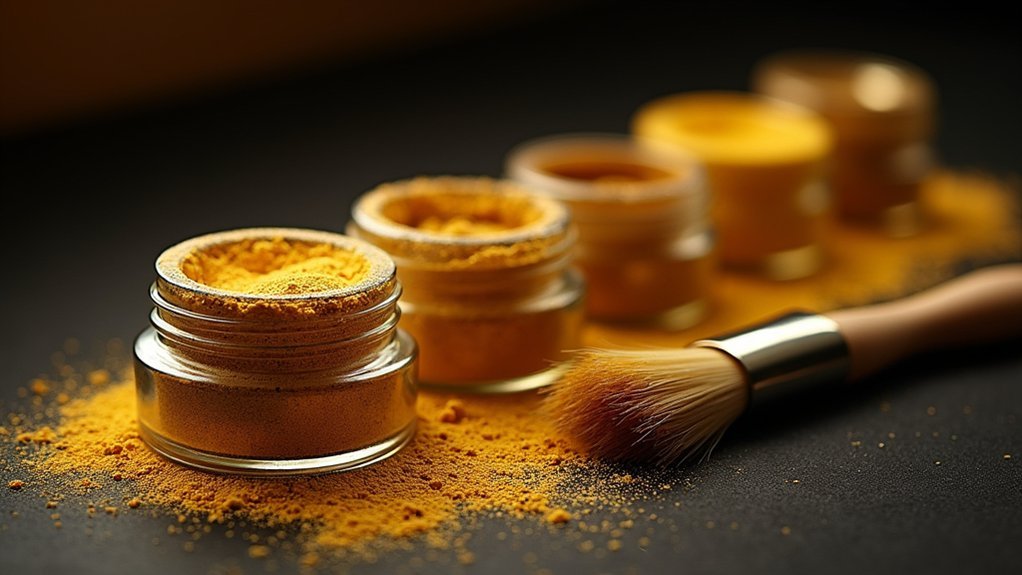
Although proper equipment sets the foundation for professional gold polishing, contamination control determines whether you’ll achieve flawless results or disappointing finishes.
Maintaining contamination-free gold polishing requires strict protocols that protect your investment and reputation. You must segregate buffing wheels and polishing compounds exclusively for gold work. Cross-contamination from other metals destroys the quality you’re working to achieve. Clean between each polishing step using ultrasonic cleaning or soapy water to eliminate residue buildup.
Follow these essential practices:
- Dedicate clean buffing wheels specifically for precious metals when applying compounds like Red Jewelers Rouge
- Employ ‘break away’ grip techniques while buffing, guaranteeing wheels roll off edges properly
- Store compounds in sealed containers and regularly maintain equipment to prevent abrasive accumulation
These protocols guarantee consistently brilliant finishes.
Frequently Asked Questions
What Is the Best Polishing Compound for Gold?
You’ll get the best results with Red Jewelers Rouge for gold polishing. It’s specifically designed for soft metals and won’t cut the surface while delivering an excellent shine that’s perfect for jewelry work.
What Do Jewellers Use to Polish Gold?
You’ll use Red Jewelers Rouge for the highest shine, Brown Tripoli for cutting and scratch removal, and Green or White Rouge for final polishing. Pair these compounds with untreated domet flannel buffing wheels.
What Is the Difference Between Jewelers Rouge and Polishing Compound?
You’ll find jewelers rouge is specifically formulated for delicate precious metals like gold and silver, while general polishing compounds vary in abrasiveness and work on broader material ranges with different cutting actions.
What Is the Difference Between Buffing Compound and Polishing Compound?
You’ll find buffing compound is coarser and removes scratches during initial surface preparation, while polishing compound is finer and creates that final high-luster finish you’re aiming for.
In Summary
You’ve now got the knowledge to transform dull gold pieces into brilliant, mirror-like finishes. Start with coarse compounds like tripoli, progress through bobbing compound, and finish with red rouge or white diamond polish. Don’t forget to use dedicated buffing wheels for each compound and keep your workspace contamination-free. With consistent technique and the right progression, you’ll achieve professional-quality results that’ll make your gold jewelry shine like new.





Leave a Reply